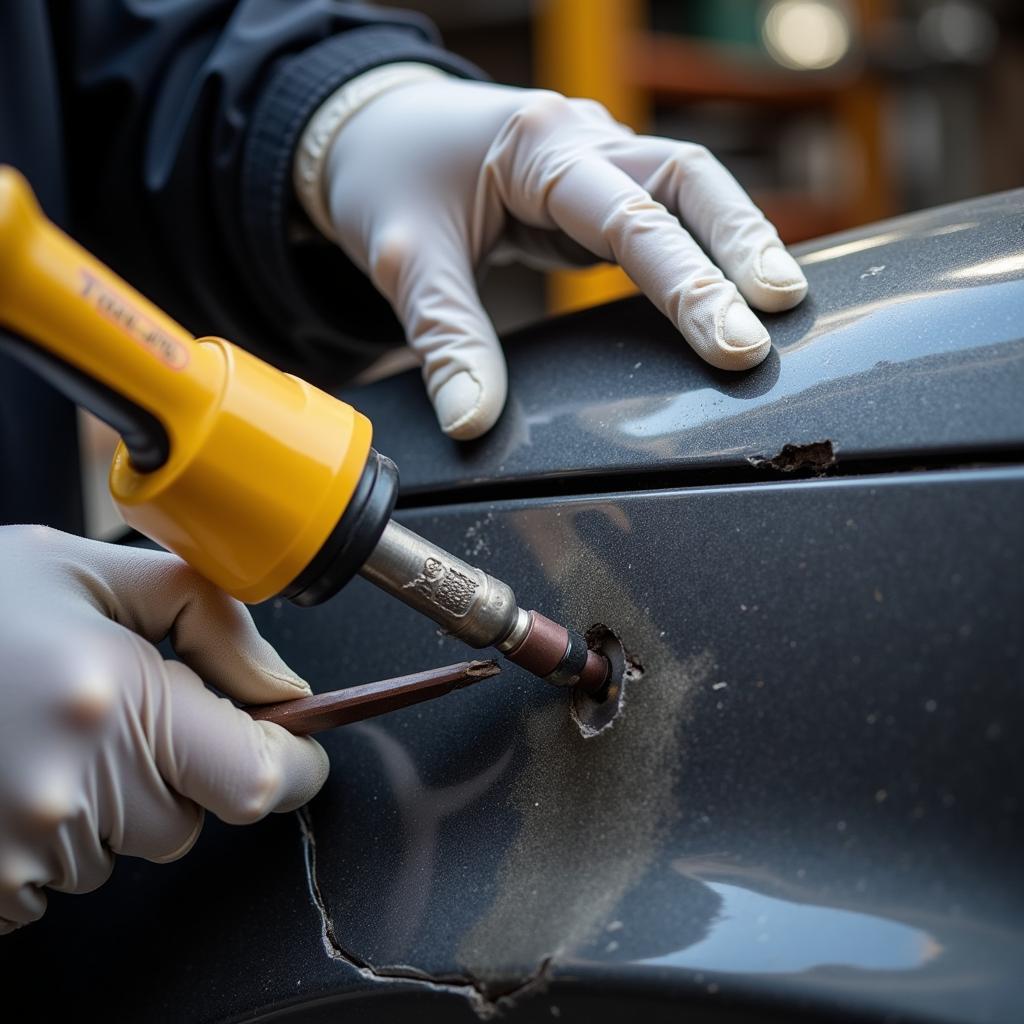Choosing the right adhesive is crucial for a successful car bumper repair. Whether you’re dealing with a minor crack or a more significant split, using the best glue ensures a strong, lasting bond. This comprehensive guide dives deep into the world of car bumper adhesives, providing you with all the information you need to make an informed decision.
Understanding Car Bumper Materials
Before selecting a glue, it’s essential to identify the material of your car bumper. Most modern bumpers are made from plastic, specifically:
- Polypropylene (PP): A flexible, impact-resistant plastic commonly used in bumpers.
- Acrylonitrile Butadiene Styrene (ABS): A rigid, durable plastic often combined with other materials for enhanced strength.
- Polycarbonate (PC): A strong, transparent plastic often used for higher-end vehicles.
Each material has unique properties, impacting the type of glue that works best.
Types of Glue for Car Bumper Repair
Several adhesives are suitable for car bumper repair, each with pros and cons:
1. Epoxy Glue
Epoxy is a two-part adhesive that forms a strong, durable bond when mixed. It’s versatile, suitable for various plastic types, and offers excellent gap-filling capabilities.
Pros:
- Strong and long-lasting
- Water-resistant and weatherproof
- Can fill gaps and irregularities
Cons:
- Requires precise mixing
- Longer curing time
2. Plastic Welding Compound
Similar to epoxy, plastic welding compounds create a strong bond and are ideal for filling large gaps and repairing structural damage.
Pros:
- Creates a permanent bond
- Can be sanded and painted
- Offers excellent adhesion
Cons:
- Requires a heat gun or soldering iron for application
- More challenging to apply than other adhesives
 Applying plastic welding compound on a car bumper
Applying plastic welding compound on a car bumper
3. Super Glue (Cyanoacrylate)
Super glue is a fast-acting adhesive that bonds quickly to various surfaces. It’s suitable for small cracks and repairs that require instant bonding.
Pros:
- Sets quickly
- Easy to use
- Affordable
Cons:
- Not as strong as epoxy or plastic welding compound
- Not suitable for filling large gaps
4. Polyurethane Adhesive Sealant
Polyurethane adhesive sealants are known for their flexibility and ability to withstand vibration. They create a strong bond and are ideal for repairing bumpers prone to flexing and movement.
Pros:
- Flexible and vibration-resistant
- Water-resistant and weatherproof
- Can be painted over
Cons:
- Longer curing time compared to super glue
- Can be messy to apply
Choosing the Right Glue: Factors to Consider
Selecting the best glue depends on several factors:
- Type and severity of damage: Small cracks require different adhesives than large splits or structural damage.
- Bumper material: Ensure the chosen glue is compatible with your bumper’s plastic.
- Desired drying time: Choose a fast-acting adhesive for quick fixes or a longer-curing option for more complex repairs.
- Your skill level: Some adhesives require more expertise than others.
Expert Insight
“Many car owners underestimate the importance of choosing the right glue for bumper repair,” says John Smith, Automotive Engineer at CarRepairOnline. “Using an incompatible adhesive can lead to a weak bond, resulting in further damage and costly repairs down the line.”
Tips for a Successful Car Bumper Repair
- Clean the surface thoroughly: Remove dirt, grease, and debris before applying the adhesive.
- Roughen the surface: Lightly sand the area to be repaired for better adhesion.
- Use clamps: Secure the repaired area with clamps to ensure proper bonding while the glue cures.
- Follow manufacturer instructions: Each adhesive has specific instructions for use and drying times.
- Consider professional repair: For significant damage or if you’re unsure about the repair process, consult a professional.
Conclusion
Repairing your car bumper doesn’t have to be a daunting task. By understanding the different types of glue available and following the tips outlined in this guide, you can achieve a strong, lasting repair. Remember to choose the best glue for your specific needs and always prioritize safety throughout the process.
Frequently Asked Questions
Can I use super glue on a car bumper?
Super glue can be used for small cracks and repairs on car bumpers, but it may not be suitable for larger damage.
How long does it take for car bumper glue to dry?
Drying time varies depending on the type of glue used. Super glue sets quickly, while epoxy and plastic welding compounds require a longer curing time.
Can I paint over car bumper glue?
Yes, most car bumper adhesives can be painted over once they are fully cured.
Is it difficult to repair a car bumper myself?
Minor bumper repairs can be done at home with the right tools and materials. However, significant damage may require professional repair.
What happens if I use the wrong glue on my car bumper?
Using the wrong glue can result in a weak bond, leading to further damage and the need for more extensive repairs.
For more information on car bumper repair, check out our articles on how to repair deep scratches on car bumper door, car bumper scratches repair, and how to repair a cracked bumper on car. You can also find a qualified car bumper repair near peebles on our website. If you need assistance with your car battery and bumper repair, we have information available on bawtry car bumper repair.
Need further support? Don’t hesitate to contact our 24/7 customer service team via WhatsApp at +1(641)206-8880 or email us at [email protected].
